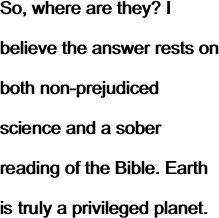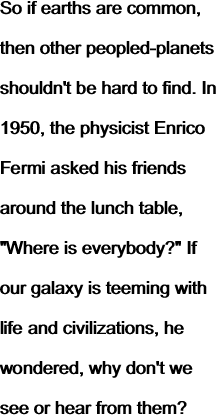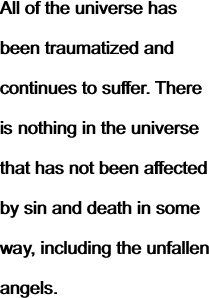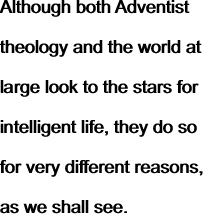 |
|
HOME | PROCLAMATION! MAGAZINE | DEVOTIONALS | STUDIES | LETTERS | ABOUT US | RELATED WEBSITES |
|
HOME / PROCLAMATION! MAGAZINE / 2008 / JANUARY/FEBRUARY / CAREY
Martin Carey grew up as an Adventist in many different places, including Washington D.C., Missouri, and Guam, USA. During daylight hours he works as a psychologist for a high school in San Bernardino, California. He is also a licensed family therapist. He is married to Sharon, and has two sons, Matthew, 6, and Nick, 20. He continues to search for clear, dark skies with seven different telescopes up to 20". The study of intelligent design takes up his remaining energy. You may contact him at martincarey@sbcglobal.net.
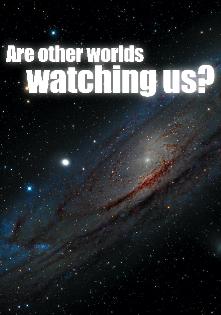
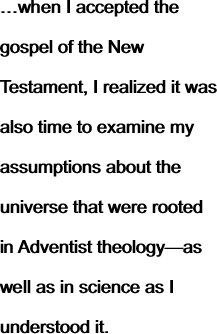
JANUARY / FEBRUARY 2008
VOLUME 9, ISSUE 1
A R T I C L E S
Are other worlds watching us?
Martin L. Carey
"We are so insignificant!" When standing out under a majestic sky full of stars with any group of people, someone always reacts with those words. Insignificance expresses a deep problem in our identity as humans and in how we view our place in the cosmos. When we realize how vast is the universe and how tiny is our earth, we conclude that earth is just a speck. Realizing our speckhood, we assume there must be trillions of intelligent but distant neighbors, many of them our superiors in morality if not intelligence. To believe that we have a unique place of privilege in the cosmos is considered "arrogant." The late Philip Knox, an eloquent Voice of Prophecy speaker and author, stated, "How can any thoughtful person believe that this world, which is such an infinitesimal part of God's colossal universe, is the only abode of life? What manner of conceit is this…?" 1 Likewise, some Christians accept the popular consensus that alien life is virtually certain.
Growing up as an Adventist, I was inspired by the belief in a "watching universe" to pursue the stars passionately. When I looked through a telescope at glories beyond our solar system, I was certain that I was beholding unfallen perfection. As time passed, observing with larger and larger telescopes became a religious duty, a holy quest. However, when I accepted the gospel of the New Testament, I realized it was also time to examine my assumptions about the universe that were rooted in Adventist theology—as well as in science as I understood it.
For Adventists, the existence of intelligent alien life is a deeply held belief founded in great controversy theology and the writings of Ellen White. The great controversy theme (GCT) is a central doctrine of the Adventist church that touches all of its theology as an "organizing principle" and is "Ellen White's distinctive theological contribution." 2 The theme involves a cosmic conflict "between Christ and Satan regarding the character of God, His law, and His sovereignty over the universe…Observed by the whole creation, this world became the arena of the universal conflict, out of which the God of love will ultimately be vindicated." 3 Ellen White made it clear that the controversy is about God's reputation.
But the plan of redemption had a yet broader and deeper purpose than the salvation of man. It was not for this alone that Christ came to the earth; it was not merely that the inhabitants of this little world might regard the Law of God as it should be regarded; but it was to vindicate the character of God before the universe.4
An essential feature of the GCT is its cosmic scope, involving a vast number of intelligent, unfallen, alien beings observing this controversy. God's character is on trial before all the populated planets, and their inhabitants are the jury. From the beginning of the controversy, these beings have been watching the trial with intense interest. Their involvement elevates the controversy to "great," for without their existence, the boundless cosmic audience for God's character demonstration is removed. Satan's power and importance are reduced if his influence is limited to our "little world."
Secular science also has a strong interest in extra-terrestrial intelligence. The SETI program (Search for Extraterrestrial Intelligence) directs well-funded research and vigorous public relations to keep feeding the popular imagination. Adventists' belief in unfallen intelligences also finds support from secular science and popular culture. Although both Adventist theology and the world at large look to the stars for intelligent life, they do so for very different reasons, as we shall see.
Ellen White's Worlds
Ellen White's earliest visions involved travel to other inhabited planets, and she mentioned them often throughout her lifetime. In late 1846 she "was wrapt in a vision of God's glory, and for the first time had a view of other planets."5 These worlds cover the expanse of the universe with "unnumbered millions." She describes beings on one of the planets she saw.
The inhabitants of the place were of all sizes; they were noble, majestic, and lovely. They bore the express image of Jesus, and their countenances beamed with holy joy…I asked one of them why they were so much more lovely than those on the earth. The reply was, "We have lived in strict obedience to the commandments of God, and have not fallen by disobedience, like those on the earth." 6
According to White, they demonstrate that God's rule of law is perpetual and universal, so we who are also in God's image need to be humbled and inspired by their example. "Men living in this little atom of a world are finite; God has unnumbered worlds that are obedient to His laws and are conducted with reference to His glory."7
The other worlds are also a battleground, according to GCT. Satan, White wrote, planned to capture the unfallen worlds for his rebellious purposes but has been unsuccessful so far. Since the beginning of the Great Controversy, he has had free access to all the worlds to "tempt and annoy" and create open rebellion against God. God's hesitation was necessary because, "for the good of the entire universe through ceaseless ages, Satan must more fully develop his principles."8 Premature divine justice against the rebellion would only confirm Satan's charges that "the principles of God's government make forgiveness impossible…and his accusations were proven true."9 This delay of divine justice was for the benefit of the watching but uncomprehending universe. "Why was it that Satan's existence was not cut short at the outset of his rebellion? It was that the universe might be convinced of God's justice in His dealing with evil."10 In the Great Controversy, the timing of divine justice has not been in God's control.
Watching Worlds and the Bible
There are a number of Bible passages and phrases that Adventist authors have presented as evidence for the existence of extraterrestrial intelligences, beginning with the Old Testament.
The Sons of God, beney elohim, beney ha'elohim, or beney elim, are found in Genesis 6:2, 6:4, in Deuteronomy 32:8 (some manuscripts), in Psalms 29:1, 89:5, as well as in three texts in Job: 1:6, 2:1, and 38:7. They are not defined but are variously translated as "angels", "mighty ones", "sons of the mighty", "assembly of the holy ones", or just "holy ones". In the first two chapters of Job, the sons of God present themselves before the Lord on two occasions, and Satan is among them both times. In 38:7, they shout for joy at the creation of our world. Knox wrote that 1:6 and 2:1 describe a counsel meeting of the worlds, that the Sons of God are representatives from those worlds, and that Adam might have been a member of this counsel but for his fall.11
Knox's interpretation is an imaginative use of Scripture, for there is no indication in these passages that the sons of God are anything exotic. Satan was a fallen angel who was permitted to appear before the Lord with other angels, as he had always done. We know he was permitted because he had access to God's presence on other occasions as well (Zech. 3:2 and Luke 10:18).
If the sons of God in the Old Testament are angels, we can make better sense of all the references to them. Knox's alien beings get into trouble in Genesis 6:6, where "…the sons of God went to the daughters of men and had children by them." White finds a more mundane identity for the Genesis beings, and states that the children of Seth who worshipped God intermarried with the worldly children of Cain.12 Probably most biblical scholars also believe the Genesis sons of God to be the sons of Seth;13 others hold that they were fallen angels,14 or that this was a general term for worshippers of God. There are arguments for each view, but the Christian commentaries don't see the sons of God as physical beings from other worlds.
Other passages with sons of God also appear to describe angels. Deuteronomy 32:8 has an enigmatic statement in some translations, "…he fixed the bounds of the peoples according to the number of the sons of God." Again, this is not likely a reference to residents of distant planets. We know that elsewhere in scripture angels with authority are called princes, principalities, authorities, powers, or rulers, as in Daniel 10 where Gabriel contends with the prince of Persia. In Daniel 3:25, the being who accompanied Daniel's three friends in the furnace resembled a "son of the gods" and was later called an angel by king Nebuchadnezzar.
In the New Testament, the term "sons of God" very plainly refers to believers, since their new life created by the Spirit has no physical genealogy. In fact, in Luke 20:36, Jesus describes how humans in the life of the age to come "…neither marry nor are given in marriage; nor can they die anymore, for they are equal to the angels and are sons of God, being sons of the resurrection." (NKJV). Lewis Chafer wrote that in the Old Testament terminology, angels are called sons of God while men are called servants of God. In the New Testament this identification is reversed. Angels are the servants and Christians are the sons of God.15
E.W. Bullinger draws together all the "sons of God" texts in both testaments:
It is only by the Divine specific act of creation that any created being can be called "a son of God." For that which is "born of the flesh is flesh." God is spirit and that which is "born of the Spirit is spirit" (John 3.6). Hence Adam is called a "son of God" in Luke 3.38. Those "in Christ" having the "new nature" which is by the direct creation of God (2 Cor. 5.17; Eph. 2.10) can be, and are called "sons of God" (John 1.13; Rom. 8.14, 15; 1 John 3.1).16
The Bible is clear that God created other worlds. Heb. 1:2 states "…by whom also he made the worlds…" while Heb 11:3 says, "Through faith we understand that the worlds were framed." Other translations have "universe" instead of "worlds." What is meant here? In our culture we are conditioned to associate "worlds" with planets, and we imagine a terrestrial planet like ours with people like us. However, the Greek, aion, can be translated as forever, worlds, universe, period of time, or age.17 It is a general term that can include the entire creation, and it does not specifically address planets or people living on them.
"Things in Heaven", mentioned in Colossians 1:19-20, speaks of something otherworldly accomplished by Christ:
For God was pleased to have all his fullness dwell in him, and through him to reconcile to himself all things, whether things on earth or things in heaven, by making peace through his blood, shed on the cross.
A. Graham Maxwell, the theologian who taught the GCT at Loma Linda University for nearly three decades, used this text as evidence for a watching universe18 and a Great Controversy. Actually, this text raises a good question: why would unfallen creation need reconciliation and peace through Christ?
Building up a Great Controversy is not needed to make sense of this text. Romans 8:20-22 states that the whole creation, and that includes everything God has made in the entire cosmos, "was subjected to frustration" and "bondage to decay," and "has been groaning as in the pains of childbirth right up to the present time." All of the universe has been traumatized and continues to suffer. There is nothing in the universe that has not been affected by sin and death in some way, including the unfallen angels. Since they have suffered with us in some sense, they need reconciliation, freedom, and peace as well.
Sin introduced discord not only on earth, but also in heaven, by the fall of demons; it brought into the abodes of holy angels, though not positive, yet privative loss, a retardation of their highest and most perfect development…Angels were no more able than men by themselves to overcome the peace disturbers, and cast out the devils; it is only "by," or "through Him," and "the blood of His cross," that peace was restored even in heaven.19
Principalities and Powers (Eph. 3:10) have also been cited as examples of unfallen beings on other worlds, but how are they mentioned in other passages?
In Romans 8:38, they are entities who might attempt to separate us from the love of Christ. In Eph. 1:21 and Col. 1:16, 2:10, they are rulers in the heavens over whom Christ is given dominion. They are disarmed and publicly humiliated in Col. 2:15. In Eph. 6:12, they are evil spiritual powers against whom we struggle. Titus is told (3:1) to remind the people to submit to human rulers and authorities. None of these are good candidates for physical beings from other worlds, as Maxwell and others claim. They are either powerful angels, evil in most cases, or they are human authorities, depending on context. While the Bible does not explicitly deny the existence of aliens, inhabitants of worlds are not discussed anywhere in scripture.
The Starry Allotment
The stars overwhelm us with their numbers and distances as we gaze at them with awe. Stars are huge, distant, and numerous, perhaps 100 billion squared. They are unimaginably powerful furnaces of nuclear fusion. The Israelites were warned of the very human reaction to worship them:
And beware lest you raise your eyes to heaven, and when you see the sun and the moon and the stars, all the host of heaven, you be drawn away and bow down to them and serve them, things that the Lord your God has allotted to all the peoples (emphasis mine) under the whole heaven (Deut. 4:19, ESV).
The heavens can declare God's glory, or they can draw us away from him so that we bow to them and serve them. In Psalms 8 David says of man, "You made him ruler over the works of your hands; you put everything under his feet." The stars are a gift to all of us under heaven.
Multiplying Worlds: A Brief History
When Copernicus launched his book On the Revolutions of the Celestial Spheres in 1543, showing that the earth orbited the sun, the Christian world began to rethink its cosmology. The church's adoption of Aristotle's ideas blended with classical Christian doctrine to put an unmovable earth at the center of the universe, with all the celestial spheres revolving about it. Humans had a central place as the special objects of God's creative and saving activity. Some theological minds, however, questioned this orthodoxy. 20
Basing his opinion on Augustine's idea that God could have made a perfect man, William of Ockham, the fourteenth-century Oxford Franciscan, declared it probable that God could create a better world than ours, and certain that he could create an infinite number of worlds identical to ours.21
Giordano Bruno was a Dominican monk who was inspired by the Greek philosophers Democritus and Epicurus and departed from the cardinal points of Christian theology. Since he embraced the idea that all things are composed of irreducible, eternal particles called atoms, he reasoned that there must be an infinity of stars and planets that are inhabited by beings like us. "Bruno believed that God's omnipotence and infinitude could only be expressed by creating an infinite number of worlds in reality, not just as a hypothetical possibility."22 Bruno was burned at the stake for a number of heresies, including pantheism.
The invention of the telescope accelerated this expansion of the creation. Galileo's discoveries of actual worlds and their motions dealt a fatal blow to earth-centered cosmology. Galileo, however, was cautious in speculating about life on other worlds, unlike many other luminaries of science such as Kepler who wrote that God specifically created Jupiter's moons for the benefit of the Jovian inhabitants. Fontenelle's successful book The Plurality of Worlds looked away from tiny earth to the realms of populated space to which theology and science should shift their attention. Fontenelle argued one case as a lawyer, and then gave his life to writing on philosophy and science. Here he expresses his forlorn mood out under the Tremendum:
Behold a universe so immense that I am lost in it. I no longer know where I am. I am just nothing at all. Our world is terrifying in its insignificance. 23
Over the next hundred years, pluralism came to be the dominant viewpoint among the thinking class. Astronomers William and his son John Herschel believed that not only are other planets inhabited with intelligent beings, but so also are the moon, the sun, and the stars. Their superlative observing skills enabled them to discern that the "spiral nebulae" were possibly separate systems of stars, or "island universes." Emmanuel Kant, the German philosopher, wrote extensively in the late 18th century about worlds ever filling more space in a "continuous extension of the Divine presence."24 There were notable exceptions to these opinions, such as William Whewell, an early proponent of the "rare earth" hypothesis, who argued brilliantly from science that the conditions for life are not common in the universe.
Many Christian contemporaries of Ellen White spoke freely of many worlds, including Charles Spurgeon and R.W. Dickinson. Spurgeon, just before his death, urged that if Christians are given to be evangelists in the next life, they will carry the story of the cross to every world.25 Before Ellen White wrote The Great Controversy, its major ideas were discussed. In 1848, Dickinson anticipated The Great Controversy with a cosmic saga reminiscent of Ellen White's grand theme, in which the angels and other worlds required a demonstration of the effects of Satan's deceptions and God's justice. Dickinson sees God driven by "moral necessity" to a practical demonstration of His goodness. Satan was allowed access to other worlds because,
…it may have been in order to refute the assumption on which Satan proceeded in his revolt, and demonstrated to the universe God's ability to exercise a wise, just, and benevolent administration over creatures who revolt.26
Cosmic pluralism, however, did not only grow out of the Copernican revolution and the discoveries of the telescope. For many believers it was also shaped by the conviction that undue concern for earth somehow diminishes God's greatness.
Mediocrity vs. Privilege
A most cherished doctrine of modern astronomy is called the "mediocrity principle," which assumes that earth has no special place in the cosmos, that we are just a typical rocky planet, orbiting an ordinary star, circling inside a conventional barred spiral galaxy.27 Among mediocrity's most devout was astronomer Carl Sagan. In a photo of earth he finds proof for dogmatic atheism and despair:
The Earth is a very small stage in a vast cosmic arena....Our posturings, our imagined self-importance, the delusion that we have some privileged position in the Universe, are challenged by this point of pale light. Our planet is a lonely speck in the great enveloping cosmic dark…there is no hint that help will come from elsewhere to save us from ourselves.28
So if earths are common, then other peopled-planets shouldn't be hard to find. In 1950, the physicist Enrico Fermi asked his friends around the lunch table, "Where is everybody?" If our galaxy is teeming with life and civilizations, he wondered, why don't we see or hear from them? They've had plenty of time to evolve and make contact. This question became known as the Fermi Paradox, and it evades an easy answer from even the most fervent SETI enthusiasts.29
But they have to be out there. Percival Lowell of Martian canals fame had no doubts:
"That we are the sum and substance of the capabilities of the cosmos is something so preposterous as to be exquisitely comic….[Man] merely typifies in an imperfect way what is going on elsewhere, and what, to a mathematical certainty, is in some corners of the cosmos indefinitely excelled."30
Sagan, Fermi, and Lowell all assumed that life originated only by the interactions of matter and energy, with no help from an intelligent agent. For mainstream science, a cosmos filled with alien intelligences is a natural outgrowth of Darwinian processes. Life's recipe is simple; just add water, simmer for a few million years, and out pops life. Given enough time, dead matter will self-organize, and random variation and natural selection may eventually produce intelligence.
In 1961 Frank Drake developed the Drake Equation that attempts to quantify the factors that determine the number of intelligent, communicating civilizations in our galaxy.31 Formulas give the appearance of rigor and legitimacy. Unfortunately, none of the Drake factors are known with any accuracy. We do not know how many stars have planets, or what portion of those planets can sustain life. Depending on the numbers one feels like plugging into the formula, the answer could be either billions or zero. With better technology, perhaps we could learn the numbers of planets in our galaxy, but detecting life would be a greater challenge by unknown orders of magnitude. With only seven factors, one is led to believe that the conditions for life are few and simple. Even worse, there is no satisfactory naturalistic explanation for the origin of life. How can scientists calculate life's chances elsewhere if they can only speculate on its origin here?
Nevertheless, SETI, NASA, our government, and much of academia have a large stake in hunting for ET; they hope that an advanced civilization can provide answers for longevity, peace, and prosperity. There is a large measure of faith involved in this quest as they hope for the smallest sign from some nameless, silent entity far away. As novelist Michael Crichton told his CalTech audience in 2003, SETI is not science; it is a religion.32
On the other hand, there are scientists who will pursue the evidence where it leads. Guillermo Gonzalez, a well-published astronomer at Iowa State University, has shown independence in his support for intelligent design, a stance probably costing him tenure. He has stimulated much controversy with his work on "habitability zones" which describe the ability of a planet, star system, or galaxy to support life. Gonzalez has compiled an impressive list of factors that must be right for life to flourish. Says Gonzalez,
Complex life in particular probably needs many of the things that we Earthlings enjoy: a rocky terrestrial planet similar in size and composition to the Earth, with plate tectonics to recycle nutrients, and the right kind of atmosphere; a large, well placed moon to contribute to tides and stabilize the tilt of the planet's axis. That planet needs to be just the right distance from the right kind of single star, in a nearly circular orbit—to maintain liquid water on its surface.33
Having the right kind of star also depends on our position in the galaxy. He estimates that at best, 5% of the stars in our galaxy lie within its habitable zone. Our sun, for example, has a nearly circular orbit around the center of the galaxy, keeping it in that zone. If we were too close to the central bulge, we would be exposed to fatal doses of radiation. If too far out, our star would lack the heavy elements needed for life's chemistry. These are only a small sample of the hundreds of known conditions needed to sustain life. Outside these conditions, space is catastrophically hostile.
The Drake Equation has been answered with a Rare Earth Equation with habitability requirements, and it doesn't attempt to calculate the number of communicating intelligences. Some critics, however, complain that the Rare Earth Equation definition of life is too narrow. Life, they argue, should not be limited to just carbon-and-water-based varieties. This objection, though, is pure speculation. No one has a clear idea of either the chemistry or the biology of alternative life forms. We have just one data point: ourselves. We are the only intelligences we have met, and there is no credible evidence that anyone has ever contacted an ET.
So, where are they? I believe the answer rests on both non-prejudiced science and a sober reading of the Bible. Earth is truly a privileged planet.
Futility vs. Hope
For the creation was subjected to futility, not willingly, but because of him who subjected it, in hope that the creation itself will be set free from its bondage to decay and obtain the freedom of the glory of the children of God (Romans 8:20,21).
From one end of the universe to the other, we see decay. The most distant galaxies are as much in bondage to decay as our bodies are. We groan and suffer, and so do the stars. Dying stars are beautiful as planetary nebulae, but when close to us, death is horrific.
Here we learn that death is much more than just a natural consequence of violating law. The futility of death we share with each other, our pets, and the stars, "is because of him who subjected [creation]." In a sermon based on Romans 8, John Piper points out that God did not passively let go of the natural order; he subjected it to decay by active decree. Our groaning isn't merely a natural state but results from a judicial act.34 This understanding is a departure from The Great Controversy's universe where decay is merely a natural result of law-breaking. The Bible, however, explains that because of sin, natural law was changed by God's decree. The futility of death is under God's control, so we have certain hope.
Our Significance
When we look at the greatness of the stars and consider how small, weak, and self-destructive we are, it is difficult to believe that we are anything special. It is outrageous to believe that humans are the only living things created in the image of God.
It is even more outrageous to believe that the Son of Man came to seek and save what was lost.35 He did not come to protect his significance before all the "watching worlds". He did not come to save anyone else—only the lost. He cared nothing for reputation and became forever human.36 Great Controversy theology portrays a hesitating, self-protecting, political God, watching his cosmic popularity polls. For Jesus, however, reputation was not something to be grasped but emptied out to the dregs. His love goes beyond anything reasonable. He's a wild, insanely reckless, romantic lover who came to rescue us from the dominion of darkness. That is why He is supreme, and that is why we love Him.
Did God reduce himself by creating only one populated planet and then giving all to save it? Of course he did! He so loved our world, "He humbled himself and became obedient to death—even death on a cross! Therefore God has exalted him to the highest place."37 Jesus Christ has supremacy over all, and we are heirs with him, by divine decree. So how will the Father "not also, along with him, graciously give us all things?"38 In him, we inherit everything.
The universe was made for man, not man for the universe.39 We find our significance in the one "who ascended higher than all the heavens, so that he might fill the entire universe with himself."40 †
Endnotes
- Knox, Phillip. Today's Amazing Universe, The Voice of Prophecy, p.75.
- Douglass, Herbert; What do Adventists Mean by the Great Controversy Theme? http://herbdouglass.50megs.com/sermons.htm
- Seventh-day Adventist Church, Fundamental Belief #8, http://www.adventist.org/beliefs/fundamental/index.html
- White, Ellen. Patriarchs and Prophets, Pacific Press Publishing Association, p.68.
- White, Spiritual Gifts, Vol. 2, p.83.
- White, The Adventist Home, Review and Herald Publishing Assoc., p. 543.
- White, Counsels to Parents, Teachers, and Students, Pacific Press Publishing Assoc., p.66.
- White, The Great Controversy, Pacific Press Publishing Assoc., p.489.
- White, The Desire of Ages, Pacific Press Publishing Assoc., p.37.
- White, Education, Pacific Press Publishing Assoc., p.308.
- Knox, Ibid, p.76,77.
- White, Patriarchs and Prophets, p.81.
- Grudem, Wayne. Systematic Theology, Zondervan, p.413.
- Missler, Chuck. Mischievous Angels or Sethites? http://www.khouse.org/articles/1997/110/
- Chafer, Lewis S. Quoted in Doctrine of Angels, Wilmington's Guide to the Bible, Tyndale House Publishers, Inc. http://m.b5z.net/i/u/6125685/f/Doctrine_of_Angels.pdf, p.16.
- Bullinger, Companion Bible, Appendix 23, Quoted in http://www.therain.org/appendixes/app23.html
- Blue Letter Bible Online, http://cf.blb.org/lang/lexicon/lexicon.cfm?strongs=165
- Gallagher, Jonathan, and Maxwell, A. Graham. Why Did Jesus Have To Die? http://www.pineknoll.org/graham/wdjhtd.pdf
- Fausset, A.R. Colossians 1, Jamieson-Fausset-Brown Bible Commentary, http://jfb.biblecommenter.com/colossians/1.htm
- Laing, Jennifer. Christian Views of Extra Terrestrial Intelligence (1600–2000): An Alien Concept? http://www.iscast.org.au/pdf/LaingETI.pdf
- Spradley, Joseph. Religion and the Search for Extraterrestrial Intelligence, p.2, http://www.asa3.org/aSA/PSCF/1998/PSCF9-98Spradley.html
- Ibid.
- Fontenelle, Bernard. Pluralit» des mondes, quoted by Edward Harrison in Masks of the Universe, Changing Ideas on the Nature of the Cosmos, p.101, http://books.google.com/books?id=A51T8mVozcoC&dq=harrison+masks+of+the+universe&printsec=frontcover&source=web&ots=eRaKRwdAjs&sig=udoHQV4VCIkufXxIqBfFqk5Vibc#PPA101,M1
- Kant, Immanuel. Universal Natural History and Theory of Heaven, p.73, http://www.eastern.edu/academic/trad_undg/honors_college/pdf/kant.pdf
- Spurgeon, Charles. The Greatest Fight in the World, http://www.spurgeon.org/misc/gfw.htm
- Dickinson, R.W., Carter, R. Religion Teaching by Example, The Theological and Literary Journal, edited by David Lord, July 1848, p.162,http://books.google.com/books?id=zOLr0vvdiHgC&pg=PA162&lpg=PA162&dq=religion+teaching+by+example+rw+dickinson&source=web&ots=bBL9YQuw9R&sig=vo-ZNc6jbLDndwpIs_WrBOUMTdo
- Wikipedia, Rare Earth Hypothesis, p.1, http://en.wikipedia.org/wiki/Rare_Earth_hypothesis
- Sagan, Carl. Pale Blue Dot, Quoted in Atheists and Agnostic's Compendium, http://rossmooratheists.info/quotes.html
- Shostak, Seth. Fermi's Paradox II: What's Blocking Galactic Civilization? Or Are We Just Blind To It? http://www.seti.org/news/features/fermis-paradox-ii-whats-blocking.php
- Richards, Jay and Gonzalez, Guillermo. Are We Alone? http://www.discovery.org/a/2143
- SETI Institute, SETI: The Drake Equation, http://www.activemind.com/Mysterious/Topics/SETI/drake_equation.html
- Crichton, Michael. Aliens Caused Global Warming, http://www.michaelcrichton.com/speech-alienscauseglobalwarming.html
- Richards and Gonzalez, Ibid.
- Piper, John. Subjected to Futility in Hope, Part 1, http://www.desiringgod.org/ResourceLibrary/Sermons/ByDate/2002/90_Subjected_to_Futility_in_Hope_Part_1/
- Luke 19:9, NIV.
- Phil. 2:7, NIV.
- John 3:16, Phil. 2:6,8,9, NIV.
- Rom. 8:32, NIV.
- Piper, Subjected to Futility In Hope, Part 2, http://www.desiringgod.org/ResourceLibrary/Sermons/ByDate/2002/91_Subjected_to_Futility_in_Hope_Part_2/
- Eph. 4:10, New Living Translation.
![]()
Copyright 2008 Life Assurance Ministries, Inc., Glendale, Arizona, USA. All rights reserved. Revised September 24, 2008. Contact email: proclamation@gmail.com

